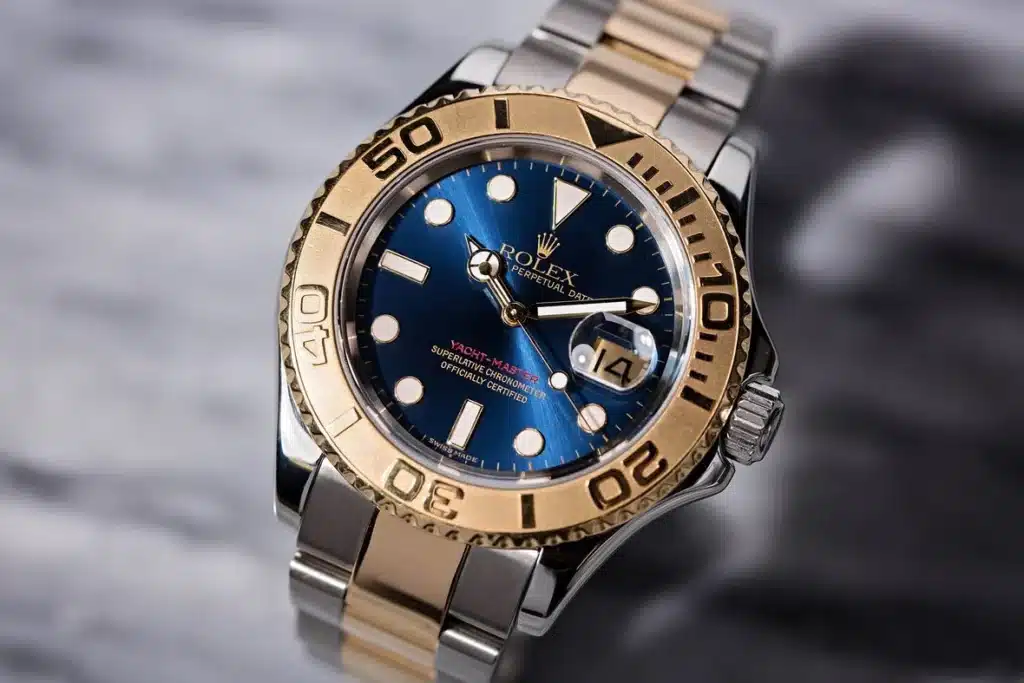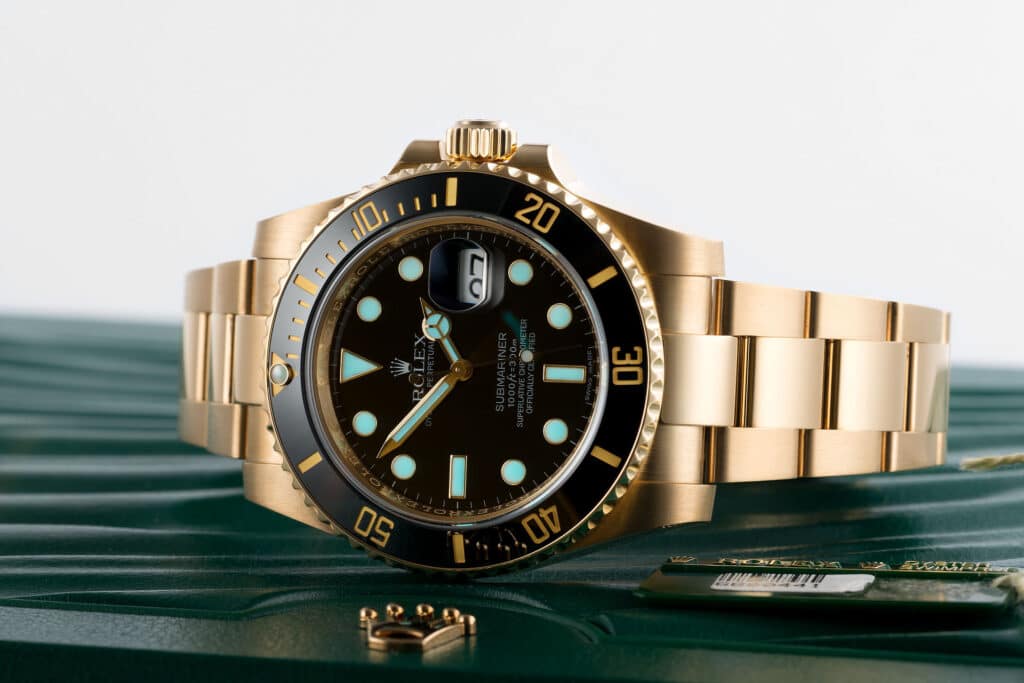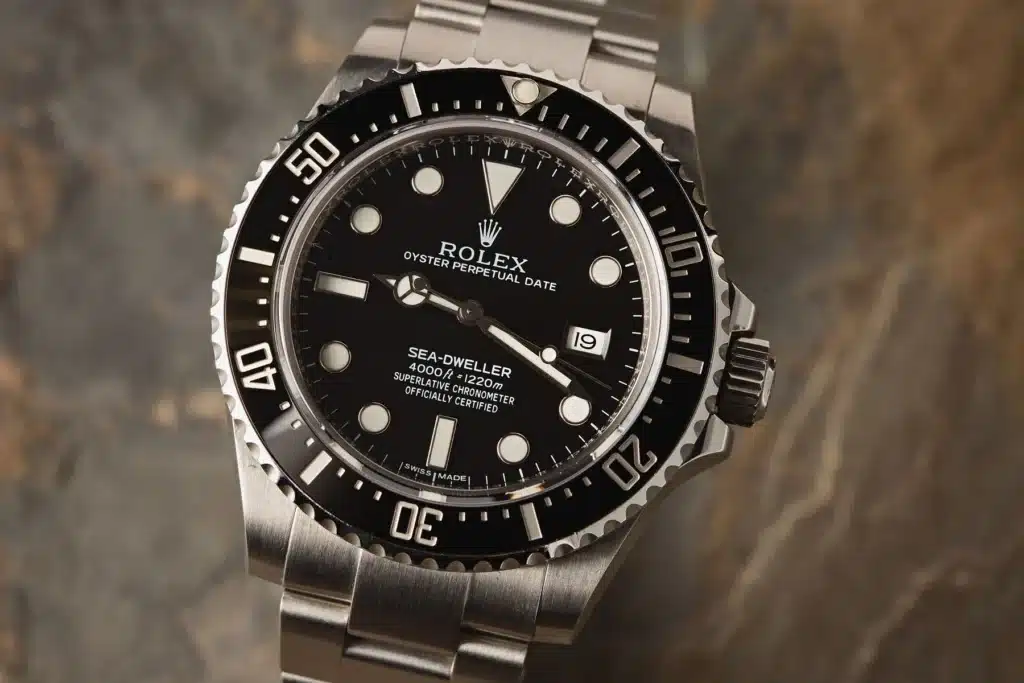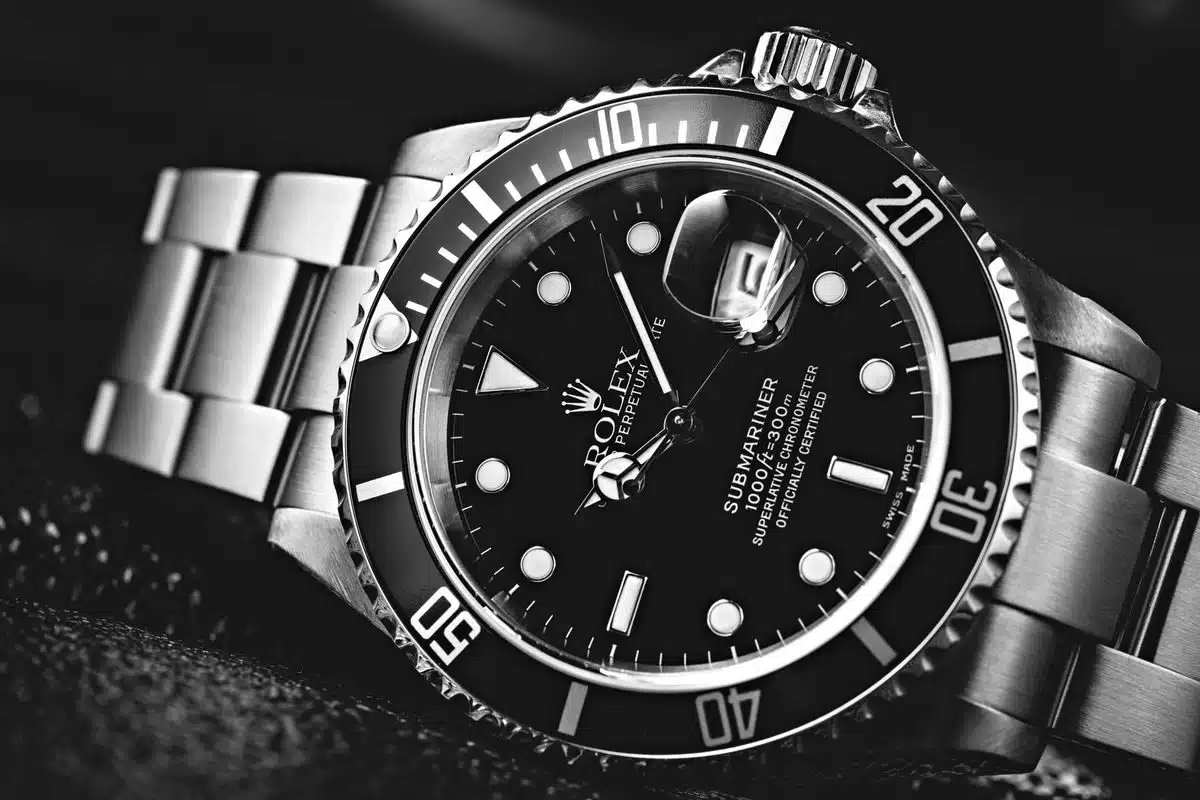Introduction
The rotating bezel is a defining feature in many diving and pilot watches, offering both utility and style. This unidirectional or bidirectional ring surrounds the watch face, allowing for easy measurement of elapsed time. Originally created for divers, it ensures a simple, reliable way to track bottom time, enhancing underwater safety. By rotating the bezel, divers align its marker with the minute hand, creating a visual countdown.
In addition to diving, rotating bezels serve practical purposes in aviation and everyday timing needs, such as cooking or exercise tracking. Crafted from high-grade materials like stainless steel, ceramic, or titanium, they offer durability and resistance to wear. Many models come with luminescent markers or numbers, ensuring visibility even in low-light conditions.
The Development And History Of The Unidirectional Rotating Bezel
First presented in the 1950s, when diving was becoming increasingly popular both recreationally and professionally, the unidirectional rotating bezel was used. Before the advent of modern digital technology, divers relied heavily on mechanical tools to ensure their safety beneath the waves. Among these essential tools, accurate time tracking was of paramount importance, as it directly affected the calculation of oxygen supply and decompression stops. One ingenious solution to this critical need was the development of the unidirectional rotating bezel, which became a hallmark feature of diving watches and revolutionized underwater timekeeping.
In its early iterations, diving watches often featured fixed bezels with minute markers, offering limited utility for timing purposes. These bezels served as a rudimentary way for divers to keep track of elapsed time but lacked flexibility and accuracy, posing potential risks during dives. The introduction of the unidirectional rotating bezel changed everything. Designed to turn only counterclockwise, this innovative mechanism minimized the possibility of accidental misadjustment underwater—a crucial safety measure. If the bezel were inadvertently moved, it could only shorten, never extend, the dive time, ensuring that divers would err on the side of caution with their remaining air supply.
Rolex and Blancpain were among the pioneering brands to integrate this feature into their diving watches. Rolex’s iconic Submariner and Blancpain’s Fifty Fathoms, introduced in the 1950s, became landmark models that set new standards for diver safety and watch functionality. The unidirectional bezel allowed divers to align the zero marker with the minute hand before submerging, creating a clear and simple way to monitor elapsed time during the dive.
Why Diving’s “Unidirectional” Matters

For divers, safety is paramount, and one of the essential features that ensure this is the unidirectional rotating bezel. This specialized bezel is designed to turn only counterclockwise, serving a crucial purpose in underwater operations. If the bezel is inadvertently moved during a dive, it can only reduce the recorded dive time rather than increase it, ensuring that divers are never misled into staying underwater longer than is safe. This design acts as a vital safeguard, preventing overstretched dive times, which can lead to dangerous nitrogen exposure or decompression sickness—two potentially life-threatening risks for divers.
In the world of diving, precise timing is everything. Before descending, divers set the bezel by aligning its zero marker with the minute hand. This allows them to track elapsed time accurately by observing the movement of the minute hand relative to the bezel’s markings. As time progresses, divers can easily glance at the bezel to determine how long they have been submerged. This simple yet effective method ensures that they are always aware of their remaining underwater time, helping them adhere to safety protocols and avoid overstaying their limits.
The unidirectional nature of the bezel serves as a built-in failsafe. Unlike bidirectional bezels, which could be moved in either direction and potentially cause miscalculations, the counterclockwise-only motion minimizes the risk of extending dive time. This gives divers peace of mind, allowing them to focus on the task at hand, whether it’s exploring underwater environments, completing technical dives, or performing rescue operations. The bezel’s robust design and practical utility make it an indispensable tool in the diving community, exemplifying how simple mechanical ingenuity can translate into enhanced safety and confidence in critical moments beneath the surface.
The Unidirectional Rotating Bezel’s Mechanism
Understanding the physics of a unidirectional rotating bezel deepens one’s appreciation of its functional and practical design, particularly in the context of diving watches. Unlike a conventional bezel, a unidirectional rotating bezel is engineered to move in one counterclockwise direction only, a feature made possible by a spring-loaded ratcheting mechanism. This restriction prevents accidental clockwise movement, providing an essential layer of safety for divers by ensuring that any unintentional bumps or shifts during a dive cannot mistakenly extend the perceived dive time. This safety mechanism helps divers accurately track their remaining oxygen supply, which is critical for underwater safety.
The bezel typically features 60-minute markings, often accompanied by minute increments that allow for precise and accurate measurement of elapsed dive time. When a diver aligns the bezel’s zero marker with the minute hand at the start of a dive, they can easily monitor the elapsed time by observing the minute hand’s position relative to the bezel’s markings. This simple yet effective design helps divers maintain focus on their environment while being aware of critical timing.
Many dive watches also feature luminous markers or numerals on their bezels, enhancing legibility in low-light or underwater conditions where visibility may be limited. These luminescent details ensure that divers can quickly and clearly read elapsed time at a glance, even in challenging underwater settings.
Useful Applications Of The Unidirectional Rotating Bezel Outside Of Diving

The unidirectional rotating bezel, originally designed as a crucial instrument for divers, transcends its underwater origins to offer practicality in various everyday scenarios. This innovative feature allows users to easily track elapsed time by rotating the bezel to align with the minute hand, providing a visual reference point for counting down or monitoring time intervals. While its primary purpose is to ensure safe dive times and monitor oxygen supply underwater, the bezel’s versatility has made it indispensable in other activities beyond diving.
For instance, in professional settings, the unidirectional bezel can help pace presentations or meetings by setting the bezel to align with the current minute marker. This enables speakers or participants to keep track of elapsed time and stay on schedule without relying on digital devices or frequent clock-checking, making it a discreet and practical tool for time management.
In the kitchen, the bezel proves invaluable for culinary tasks, serving as a timer to track cooking or baking durations. Instead of using separate kitchen timers or checking the oven frequently, users can set the bezel and easily monitor when dishes are ready, adding a touch of convenience and precision to meal preparation.
Unidirectional Rotating Bezel In Various Watch Styles
Though it is mainly associated with dive watches, the unidirectional rotating bezel appears in numerous forms, including sports watches, tool watches, and even some luxury timepieces. Companies such as Rolex, Omega, and Seiko have popularized dive watches with this bezel, which mixes with design. Appealing to individuals who appreciate both use and style, the Rolex Submariner, Omega Seamaster, and Seiko Prospex models all have notable unidirectional rotating bezels.
Apart from use, the design and color selections of the bezel may improve the watch’s visual appeal. Many bezels are available in black, blue, or green; some versions even use two-tone designs to signal varying time zones or depths. These artistic decisions have helped to explain the appeal of the unidirectional bezel as a design element that maintains practical utility while making a watch visually arresting.
Improving Accuracy And Safety Using A Unidirectional Rotating Bezel
The safety element provided by a unidirectional rotating bezel cannot be overstated. Designed to turn in only one direction—typically counterclockwise—this bezel ensures that any accidental movement can only shorten the remaining dive time, rather than extend it. This crucial feature minimizes the risk of overestimating how much air is left in a diver’s tank or how long they have been submerged, reinforcing its role as an essential safety device.
Although modern dive computers have largely taken over the responsibilities of tracking time and decompression during professional dives, many divers still rely on the bezel as a dependable analog backup. Setting the bezel at the start of a dive allows for a quick visual reference, which remains invaluable for both seasoned divers and beginners.
In situations where a digital device malfunctions, breaks down, or is lost, the unidirectional rotating bezel becomes a lifeline, ensuring divers can continue to track their remaining time underwater safely. Its simplicity and mechanical reliability have kept it a critical feature in dive watches for decades.
Precision is at the heart of the bezel’s functionality, allowing divers to depend on accurate readings. Each distinct click of the bezel aligns perfectly with a minute marker, ensuring precise adjustments when measuring elapsed time. This mechanical precision, combined with ease of use, makes it indispensable for divers who need reliable, real-time feedback during their underwater excursions.
Comparing Bidirectional And Unidirectional Bezels

Although the unidirectional rotating bezel is specifically designed for diving purposes, many timepieces on the market feature bidirectional rotating bezels. The unidirectional bezel’s primary function is to help divers track their time underwater safely, allowing them to monitor remaining oxygen supply and dive duration with precision. By moving in only one direction, it prevents the possibility of inadvertently extending the dive time. If a diver were to accidentally nudge or rotate the bezel, it would only reduce the displayed dive time, offering a built-in safety mechanism. This feature provides essential protection, making it the preferred choice for serious dive watches.
On the other hand, bidirectional rotating bezels are more versatile in their functions and appeal to a broader range of watch enthusiasts. Unlike unidirectional bezels, which rotate in one direction (counterclockwise), bidirectional bezels can move freely in both directions. This capability allows for more complex and practical uses, such as tracking a second time zone—a feature especially useful for travelers—or measuring other elapsed time intervals outside of underwater activities. Bidirectional bezels are commonly found on aviation watches and certain chronographs, offering flexibility in various situations.
Despite their versatility, bidirectional bezels are less suitable for diving purposes due to their inability to lock movement in a single, protective orientation. This makes them less desirable for situations that demand precise and fail-safe timing, such as underwater dives. However, for users who value adaptability and need a quick reference for dual-time zones, countdown timers, or general timing, the bidirectional bezel remains a valuable feature.
Conclusion
Combining safety with utility in a single, practical design, the unidirectional rotating bezel remains a timeless and necessary element of dive watches. Originally designed to satisfy mid-century divers’ needs, this bezel type has evolved beyond its original use to become a useful tool for everyone in need of a consistent method of measuring elapsed time. From professional divers to casual watch lovers, the unidirectional rotating bezel appeals to a broad spectrum of consumers since its roots are in diving history. Tracking diving time or timing a morning exercise, the unidirectional spinning bezel captures the ideal mix of design, safety, and utility.
Frequently Asked Questions
1. Why would one use a unidirectional spinning bezel?
The unidirectional spinning bezel’s main use is to give divers a consistent means of tracking underwater elapsed time. Its one-way movement guarantees that unintentional rotation won’t increase dive time, therefore improving diver safety.
2. In what way would one employ a unidirectional rotating bezel?
At the beginning of your dive, line the zero marker—often an arrow or dot—with the minute hand of the watch. The minute hand moves to show the elapsed time against the bezel’s marks.
3. Can non-diving uses be made of a unidirectional spinning bezel?
Indeed, many people find it useful for daily time requirements, including cooking, exercise, meetings, or business travel, so it is a flexible tool even for non-divers.
4. Why does the bezel rotate only in one direction?
Should the bezel be bumped or twisted, the unidirectional design prevents the inadvertent extension of dive time. This guarantees that divers do not exceed safe diving limitations since any unintentional movement serves merely as a safety precaution by shortening the timing.
5. Do unidirectional rotating bezels abound in all dive watches?
This is a standard feature of diving watch design; thus, most conventional dive watches contain this function. Some modern timepieces may incorporate digital displays or other timing systems.






